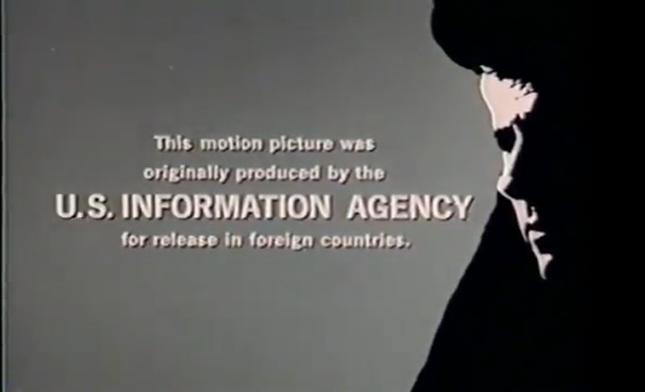Friday, November 22, will be day of remembering all over Washington, D.C., and the country and the world, but especially here in a city full of venues and cultural institution which will dedicate themselves to commemorating and remembering the 50th anniversary of the assassination of President John F. Kennedy in Dallas, Texas.
Among the numerous screenings, talks, exhibitions and the like, the screening of a 50-year-old movie about Kennedy, his legacy and his death and funeral with a talk by its producer might not seem like such a big deal.
But the 3 p.m. screening of “John F. Kennedy: Years of Lightning, Day of Drums,” and an introduction and discussion by its producer George Stevens, Jr., is a big deal. The film—a documentary written and directed by Bruce Herschensohn, produced by Stevens and created in the immediate aftermath of the assassination for the U.S. Information Agency—has not been seen in years. An expertly restored version of the film, narrated by Gregory Peck, is now available as a DVD.
“I hadn’t seen it myself for a number of years,” said Stevens, a noted film and television director, producer of the Kennedy Center Honors and founder of the American Film Institute, “The negative was lost, God only knows how. The prints from an inter-positive negative, I think—which I did see—were smudged, cracked, awful. I didn’t think it could ever be restored properly, but the people at Warner Brothers who restored “Giant,” which was directed by my father George Stevens, did a remarkable job of restoration. When I saw it, it was an amazing experience for me.”
Stevens, who was then head of the film department of the USIA, proposed the project to its director Edward R. Murrow. “At the time, we had never made a feature length film before,” Stevens said. “We used 35-millimeter color film in filming the funeral and the internment and the lighting of the eternal flame, and I still recall how vivid the colors were, how real everything seemed, even today. We did not have color television yet at time. Looking at it for the first time in a long time, I was amazed how energizing the color was.”
The structure of the film began with the inauguration speech, went to the somber days of the funeral, and went back and forth among the administration’s major achievements, including the creation of the Peace Corps, the Alliance for Progress, the Civil Rights Movement, the U.S. space initiative, the Cuban missile crisis, and efforts at world peace with the signing of the Nuclear Test Ban Treaty and back to the funeral. All through the film, you see the president and his family, mostly, the president in crowds, the president on his trip to his ancestral homeland in Ireland and the president in Costa Rica among cheering crowds.
The narration by the familiar (to an older generation) voice of Peck seems in spots old-fashioned, with the imagery rooted firmly in its time and places. It has a grieving, but also idealistic tone and feel to it, a documentary made by a wounded heart clasping hope for a permanent legacy to its bosom. It is a documentary in the sense that everything in it is real—and therefore powerful and moving—but it is a documentary which embraced the president’s pragmatic idealism, fueled by grief and dashed dreams.
“We sent camera crews to 14 countries to capture the world’s reaction,” Stevens said. “By law, we were not supposed to be allowed to screen for American public consumption, since the agency created material for overseas consumption. But the congress passed a special law allowing this film to be distributed in the United States in 1964. There was a screening at the State Department, which the New York Times film critic Bosley Crowther attended, and he praised the film in the highest terms.”
“I don’t what the box office results were, but I think it did very well and it was popular,” Stevens said.
“You know that it is a film very much of its times,” he said. “But Kennedy, he seems so real in it, he speaks very much to us still. I have my own feelings about what might have happened and I think the country as a whole would have been better for that. He had a quality. He inspired men and women to do, not just to dream, to change the world through action.”
That ability to inspire on the part of Kennedy—and his much-lauded humor– comes through in the film, he might as well be alive so vivid are the scenes of his speech at the inauguration, after entering in the wake of top-hatted Ike and Nixon, his reception in Costa Rica, the gladness of it all, and the sheer happiness on display among the crowds all over Ireland.
What makes the film truly powerful—you can scrutinize it all you want for flaws or cinematic style, but no matter—is its artlessness. It is not seamless, the language is often culturally and socially anachronistic, things move too swiftly in the funeral procession of the mighty led by Charles De Gaulle. But it’s not presenting art. Viewed from this distance by people who were alive then and have echoes in their heads about the day of drums, it’s almost shattering to see Caroline—now the U.S. Ambassador to Japan—along with Jackie, Ted and Robert, and, John, Jr., saluting. Viewing this is knowing the rest of the story, which is the story of our lives.
On Friday, Nov. 22, there will be noon and 3 p.m screenings of the film at the American History Museum; George Stevens will speak at the 3 p.m. showing.


